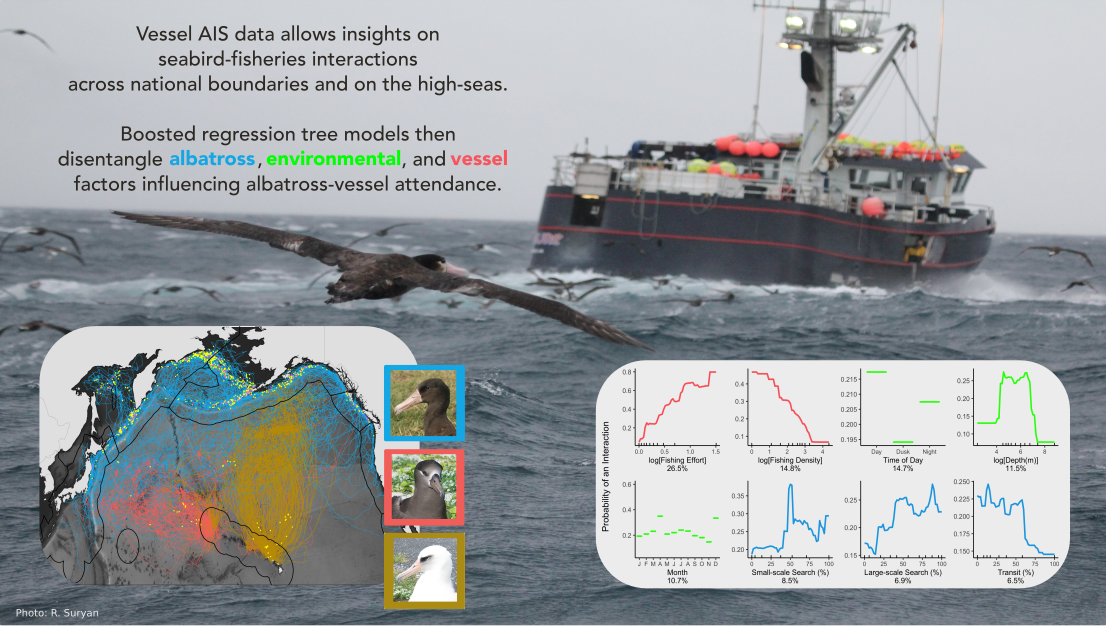
Infographic from the Facebook page of Pacific Rim Conservation
Rachael Orben (Department of Fisheries and Wildlife, Oregon State University, Newport, USA) and colleagues have published open access in the Journal of Applied Ecology on associations between the three species of North Pacific albatrosses and fishing vessels.
The paper’s lengthy abstract follows:
“Understanding encounters between marine predators and fisheries across national borders and outside national jurisdictions offers new perspectives on unwanted interactions to inform ocean management and predator conservation. Although seabird–fisheries overlap has been documented at many scales, remote identification of vessel encounters has lagged because vessel movement data often are lacking.
Here, we reveal albatrosses–fisheries associations throughout the North Pacific Ocean. We identified commercial fishing operations using Global Fishing Watch data and algorithms to detect fishing vessels. We compiled GPS tracks of adult black‐footed Phoebastria nigripes and Laysan Phoebastria immutabilis albatrosses, and juvenile short‐tailed albatrosses Phoebastria albatrus. We quantified albatrosses‐vessel encounters based on the assumed distance that birds perceive a vessel (≤30 km), and associations when birds approached vessels (≤3 km). For each event we quantified bird behaviour, environmental conditions and vessel characteristics and then applied Boosted Regression Tree models to identify drivers and the duration of these associations.
In regions of greater fishing effort short‐tailed and Laysan albatrosses associated with fishing vessels more frequently. However, fishing method (e.g. longline, trawl) and flag nation did not influence association prevalence nor the duration short‐tailed albatrosses attended fishing vessels. Laysan albatrosses were more likely to approach longer vessels. Black‐footed albatrosses were the most likely to approach vessels (61.9%), but limited vessel encounters (n = 21) prevented evaluation of meaningful explanatory models for this species of high bycatch concern.
Temporal variables (time of day and month) and bird behavioural state helped explain when short‐tailed albatrosses were in close proximity to a vessel, but environmental conditions were more important for explaining interaction duration. Laysan albatrosses were more likely to associate with vessels while searching and during the last 60% (by time) of their trips.
Our results provide specific species–fisheries insight regarding contributing factors of high‐risk associations that could lead to bycatch of albatrosses within national waters and on the high seas.
Policy implications. Given the availability of Global Fishing Watch data, our analysis can be applied to other marine predators—if tracking data are available—to identify spatio‐temporal associations, thus enabling predictive modelling and targeted mitigation measures.”
Read a popular account of the publication by the senior author.
Orben, R.A., Adams, J., Hester, M., Shaffer, S.A., Suryan, R., Deguchi, T., Ozaki, K., Sato, F., Young, L.C., Clatterbuck, C., Conners, M.G., Kroodsma, D.A. & Torres, L.G. 2021. Across borders: external factors and prior behavior influence North Pacific albatross associations with fishing vessels. Journal of Applied Ecology. doi.org/10.1111/1365-2664.13849.

 English
English  Français
Français  Español
Español